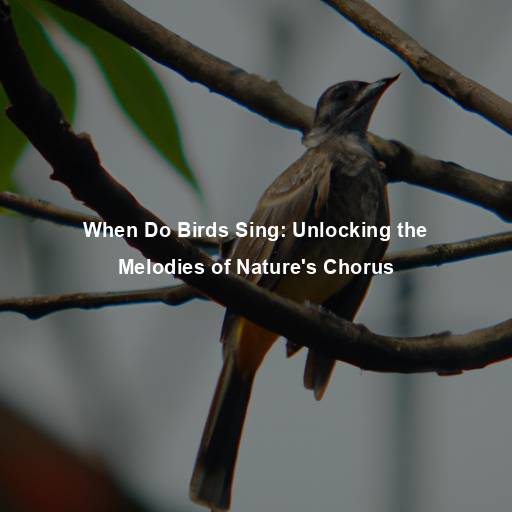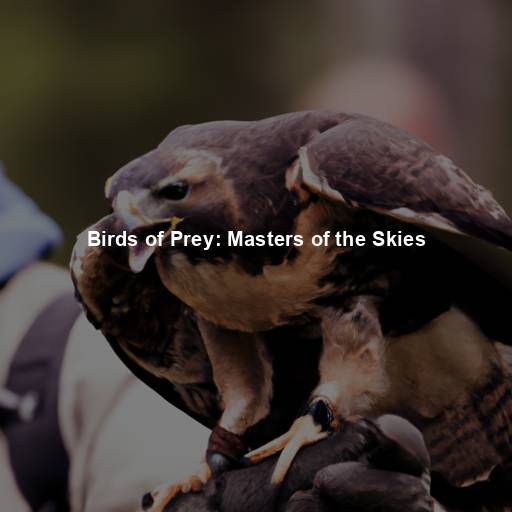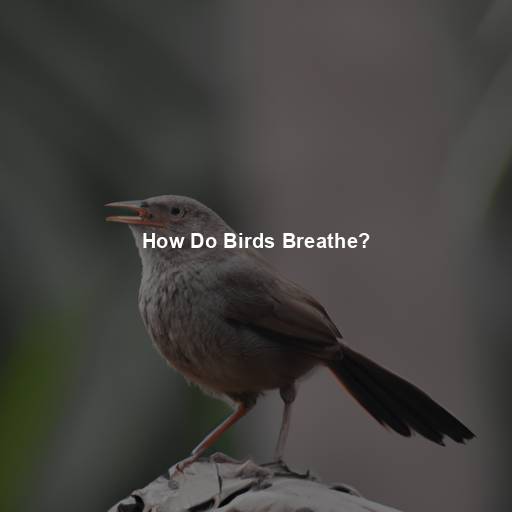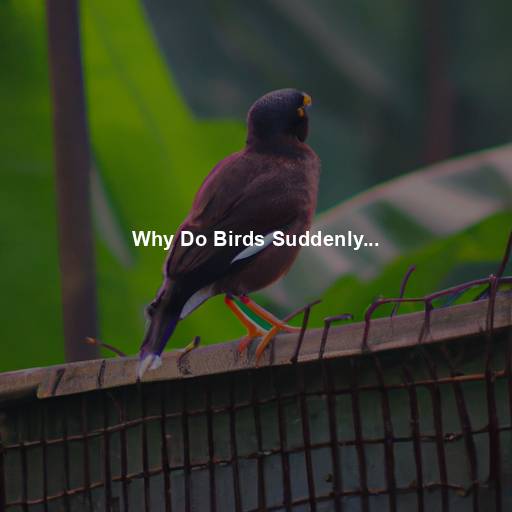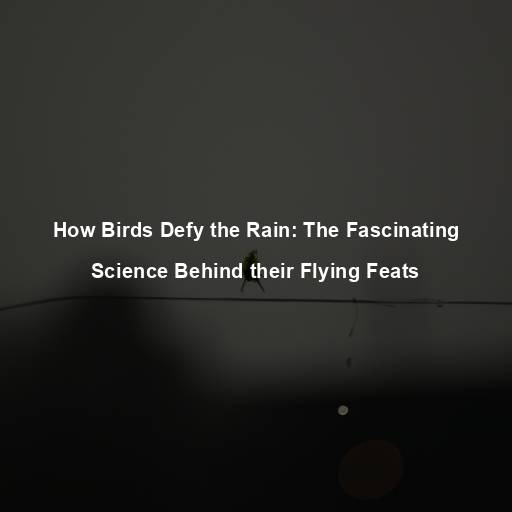When Do Birds Sing: Unlocking the Melodies of Nature’s Chorus
Last Updated on August 4, 2023 by Evan
Contents [hide]
- 1 A Symphony of Melodies: The Enchanting World of Birdsong
- 1.1 The Language of Love: Courtship and Mating Calls
- 1.2 Rise and Shine: The Dawn Chorus
- 1.3 A Wake-Up Call: Why Birds Sing at Dawn
- 1.4 The Sounds of Sanctuary: Defending Territories
- 1.5 Nature’s Alarm Clock: Vocalization Patterns Throughout the Day
- 1.6 The Melody of Nature: Environmental Influences on Birdsong
- 1.7 A Lifelong Learning: The Development of Birdsong
- 1.8 The Magic of Birdsong: A Universal Language
- 1.9 Melody in Motion: The Variety of Birdsong
- 1.10 The Early Bird Gets the Worm: Morning Singers
- 1.11 The Master Composers: Complex Songs and Repertoires
- 1.12 The Science of Birdsong: Studying the Melodies
- 1.13 Singing in Harmony: The Social Functions of Birdsong
- 1.14 The Influence of Environment: Habitat and Song
- 1.15 Adapting to Urban Environments: The City Sings
- 1.16 Our Connection to Birds: The Power of Birdsong
- 2 Celebrating the Melodies: A Tribute to Birds
- 3 FAQs for When do Birds Sing
- 3.1 What time of day do birds usually start singing?
- 3.2 Do birds sing throughout the day?
- 3.3 Why do birds seem to sing more in spring?
- 3.4 Do all bird species sing?
- 3.5 Are there specific weather conditions that influence bird singing?
- 3.6 Can city noises affect bird singing?
- 3.7 Do birds stop singing at night?
A Symphony of Melodies: The Enchanting World of Birdsong
Birdsong is one of nature’s most captivating and enchanting phenomena. As the sun begins to rise, the air comes alive with a symphony of melodies, each note carrying the spirit of the avian world. But have you ever wondered why and when birds sing? Join us on a journey as we unravel the secrets behind this mesmerizing phenomenon and explore the intricacies of nature’s chorus.
The Language of Love: Courtship and Mating Calls
Birdsong is not just a random act of musical expression; it serves a vital purpose in the avian world. For many species, singing is an integral part of courtship rituals and mating displays. Male birds use their melodious voices to attract potential mates, showcasing their fitness and prowess through complex and captivating songs. Each species has its unique repertoire of calls, ranging from simple chirps and whistles to elaborate trills and warbles.
Rise and Shine: The Dawn Chorus
As the first rays of sunlight stretch across the horizon, an ethereal concert begins. Known as the “dawn chorus,” this orchestral performance is a daily ritual for many bird species. The dawn chorus serves multiple purposes, including defending territories, proclaiming ownership, and establishing social hierarchy. By singing at the break of dawn, birds can stake their claim on their nesting grounds and communicate with neighboring individuals, ensuring peaceful coexistence in their avian communities.
A Wake-Up Call: Why Birds Sing at Dawn
Ever wondered why the feathered creatures take center stage in the pre-dawn spectacle of sound? Brace yourself, for there are manifold theories swirling in the air. One captivating hypothesis twirls around the notion that the hushed serenity of the early morning emboldens sound to traverse far and wide, carrying their melodious pitches to woo potential partners or challenge rivals residing at distant perches. Delving further into this avian symphony, another notion flutters by, propounding that the dawn chorus operates as a synchronized symphony, with each chirp serving as a cue for these winged artists to choreograph their day-long activities in perfect harmony.
The Sounds of Sanctuary: Defending Territories
Birdsong is not limited to courtship and mating rituals; it also plays a crucial role in defending territories. Male birds often use their vocal prowess to establish and protect their nesting territories from intruders. These territorial songs act as a sonic boundary, warning other males to keep their distance and signaling to females that this area is a safe haven for raising their young. The complexity and power of a male bird’s song can convey valuable information about his strength and ability to defend his turf, influencing the perception of potential rivals and potential mates.
Nature’s Alarm Clock: Vocalization Patterns Throughout the Day
Birds are renowned for their mesmerizing dawn chorus, but their melodic symphonies extend far beyond the early hours. Throughout the day, these avian virtuosos continue to grace the world with their musical talents, each species boasting its distinctive vocalization patterns tailored to specific moments in time. Whether it’s the morning serenades and twilight ballads that fill the air, or the sporadic bursts of song during meal times or in the face of danger, birds navigate a complex interplay of environmental cues, social dynamics, and their very own biological makeup to create their enchanting melodies. The awe-inspiring diversity and intricate timing behind bird songs never cease to astound and perplex us.
The Melody of Nature: Environmental Influences on Birdsong
It’s a mesmerizing symphony that transcends the boundaries of nature – birdsong. And while we often attribute its melody to an innate instinct, the truth is far more complex. As it turns out, the environment plays a crucial role in shaping bird vocalizations. From the whims of temperature to the capriciousness of weather patterns, these external forces greatly influence both the frequency and fervor of their songs.
A Lifelong Learning: The Development of Birdsong
The captivating melodies of birdsong are a mesmerizing symphony that lingers in the air, but did you know that it’s not simply a result of instinct? Like us humans, birds embark on a perplexing journey of vocal learning, crafting their songs with patience and persistence. As fledglings, these avian musicians rely on a combination of innate predisposition and imitation of their adult counterparts to refine their species-specific tunes. It’s during a critical period of their early lives that they undergo this sonic metamorphosis, ensuring their songs align harmoniously with their feathered compatriots.
The Magic of Birdsong: A Universal Language
Birdsong transcends borders and language barriers, captivating hearts and minds around the world. Whether it’s the haunting melodies of the nightingale, the rhythmic chants of the mockingbird, or the vibrant tunes of the canary, birds have an unparalleled ability to evoke emotions and connect us with the wonders of nature. Their songs have inspired countless poets, musicians, and artists throughout history, reminding us of the beauty and diversity of our natural world.
Unlocking the secrets of the avian world, we delve into the captivating symphony of bird melodies. From courtship rituals to territorial disputes, these winged creatures use their voices to communicate, captivate, and connect. As day breaks, the dawn chorus serenades us, while throughout the day, their songs paint vibrant soundscapes in nature’s grand orchestra. So, immerse yourself in the enchanting language of birds, and let their melodies awaken a sense of wonder and awe within.
Melody in Motion: The Variety of Birdsong
Birdsong is far from boring and predictable; it is a captivating symphony of unique melodies. Each bird species boasts its own distinct song, serving as a powerful tool for identification and differentiation. These melodies can range in pitch, rhythm, and duration, offering a vibrant tapestry of avian communication. Some birds, like the skilled skylark, even showcase their vocal talents while soaring through the air, impressing us with their flexibility and acrobatics.
The Early Bird Gets the Worm: Morning Singers
As the sun rises, a symphony of celestial melodies fills the air, captivating our senses with its ethereal beauty. But hold onto your feathers, for not all avian creatures partake in this melodious spectacle. Oh no, my curious reader, there are some feathered friends who prefer to save their lyrical exploits for later in the day. Picture this: as the sun begins its descent, casting shadows upon the land, a magical transformation occurs.
The Master Composers: Complex Songs and Repertoires
Birdsong is not merely a random collection of notes; it often follows intricate patterns and structures, resembling a musical composition. Certain species, like the nightingale, possess an astonishing repertoire of songs, with each male capable of producing hundreds of different melodies. These complex songs serve as a means of individual identification and can span several minutes, showcasing the remarkable memory and vocal dexterity of these avian virtuosos. The ability to learn and reproduce intricate songs is a testament to the intelligence and adaptability of birds.
The Science of Birdsong: Studying the Melodies
For centuries, researchers and naturalists have been captivated by the melodies of birdsong. The study of birdsong, known as bioacoustics, combines biology, ecology, and acoustics to unravel the mysteries behind these captivating melodies. Scientists utilize specialized equipment, such as sound recorders and spectrographs, to analyze and decipher the intricacies of birdsong. By examining the patterns, frequencies, and variations within bird vocalizations, researchers can gain insights into their behavior, evolution, and ecological roles.
Singing in Harmony: The Social Functions of Birdsong
Birdsong is so much more than just a solo performance; it’s a mesmerizing symphony that connects birds on a whole different level. It’s like their own secret language, helping them build relationships and navigate their avian world. Take duetting, for instance – it’s like a musical duet, with male and female birds harmonizing their voices to strengthen their bond and broadcast their territory to others. It’s fascinating how these feathered friends use their melodies to maintain order and effectively communicate with their partners.
The Influence of Environment: Habitat and Song
Birdsong, a marvel that transcends the boundaries of anatomy and acoustics, is a fascinating symphony orchestrated by a collaboration of nature’s forces and the bird’s very essence. The intricate tapestry of a bird’s sonic expressions is a testament to the interweaving influences of its inner world and the outer realm it inhabits. As diverse habitats unfold across the globe, so too do the melodies that ripple through the air, creating a wondrous medley of regional variations. In the secluded depths of dense forests, where nature’s whispers intertwine, birds embrace complexity, pouring their souls into intricate compositions to rise above the audial commotion.
Adapting to Urban Environments: The City Sings
In a world where urbanization collides with nature, something truly intriguing happens. Birds, known for their harmonious melodies, find themselves navigating concrete landscapes with their beautiful songs. It’s a curious twist of fate, really. These urban-dwelling birds, influenced by the symphony of city sounds, have developed their own unique vocalizations.
Our Connection to Birds: The Power of Birdsong
Birdsong has a profound impact on us as humans, transcending cultural boundaries and evoking a range of emotions. The melodies of birds can inspire awe, tranquility, and even nostalgia, connecting us to the natural world and reminding us of our place within it. Birdwatching and listening to birdsong have become popular pastimes, providing solace, relaxation, and a deeper appreciation for the beauty and diversity of our avian companions. As we listen to the symphony of nature’s chorus, let us cherish these moments and recognize the importance of preserving the habitats that enable birds to share their melodies with us.
Celebrating the Melodies: A Tribute to Birds
Birdsong possesses a profound ability to captivate and enthrall, leaving us both pondering and in awe of the natural world. Through their melodic calls and harmonious performances, birds gift us with a unique lens into their intricate and captivating lives. Not only do these symphonies enrich our very existence, but they also play a pivotal role in maintaining the delicate ecological equilibrium of our planet. As we find ourselves humbled by the enchanting melodies of these songsters, it becomes paramount that we embrace our responsibility as custodians of our environment and tirelessly work towards safeguarding the habitats that enable these avian maestros to grace us with their enchanting serenades.
FAQs for When do Birds Sing
What time of day do birds usually start singing?
As the sun timidly unveils itself on the horizon, an enchanting symphony begins to fill the air. Just before sunrise, the avian world awakens, bursting forth with a cacophony of musical notes, as if competing for the spotlight in a grand opera. This harmonious ritual, known as the morning chorus, unveils the extraordinary energy and ardor that birds possess. With each melodious tune, they stake their claim to coveted territories, serenade potential partners, and engage in a complex language spoken only by those who soar the skies.
Do birds sing throughout the day?
Birds, known for their melodious chirping, engage in constant bursts of delightful song throughout the day, their voices ebbs and flows like a perplexing symphony. While each species has its idiosyncratic patterns, the avian choir harmonizes at heightened moments of activity or when the feathered creatures cross paths. Some birds prefer specific time slots to showcase their vocal prowess, such as the breeding season or the enchanting hours before a stunning sunset. So, prepare to be serenaded by our feathered friends, for their melodic performances are truly a marvel to behold.
Why do birds seem to sing more in spring?
Birds sing more in spring because it is the breeding season for many species. Males use their songs to attract mates and establish territories, making the onset of spring the perfect time for them to show off their vocal abilities. Singing is an essential part of courtship behavior, allowing birds to communicate their readiness to breed, defend their territory, and signal their fitness to potential mates.
Do all bird species sing?
Birds, oh the enchanting creatures of the skies! Their voices, so diverse and captivating, fill the air with a symphony of sounds. But did you know that not all bird species sing in the conventional way? Indeed, while song is often attributed to male birds, there are some species where both males and females join in this melodic display.
Take, for instance, the parrots and songbirds, celebrated for their intricate and mesmerizing melodies. These feathered virtuosos command attention with their complex harmonies, leaving us in awe. On the other wing, woodpeckers and pigeons favor a different musical approach, opting for more repetitive and distinct calls, tailored to their communication needs.
So, whether it’s the dulcet tones of a warbler or the rhythmic taps of a woodpecker, each delightful species brings its unique vocalization repertoire to the avian orchestra, showcasing their adaptability and communication prowess. Let us rejoice in the majesty of these beguiling voices that grace our natural world, a melodious testament to the wonders of nature.
Are there specific weather conditions that influence bird singing?
Birds seem to have an interesting relationship with the weather when it comes to their singing habits. Sunny days with comfortable temperatures appear to be the ideal setting for most birds, as they become more lively and sing with fervor, perhaps taking advantage of the perfect conditions for various aspects of their lives, including foraging and mating. However, some peculiar species like cuckoos and owls defy this expectation and show higher activity levels during cloudy or overcast days. Furthermore, it’s quite perplexing to learn that certain birds, like the enchanting nightingales, seem to embrace the rain as an opportunity to crank up the volume of their songs, potentially amplifying their chances of attracting potential partners.
Can city noises affect bird singing?
It’s a question that has puzzled nature enthusiasts and ornithologists alike: does the incessant buzz of city life have an impact on the melodious chirping of our feathered friends? Surprisingly, the answer is a resounding yes. As urban areas continue to teem with human activity, the cacophony of urban noise, from blaring horns to bustling crowds, can create quite a conundrum for our feathered companions. Their songs, a symphony of communication, can often be drowned out in the urban chorus, forcing some birds to adapt their tunes to be heard above the urban fray. From singing at higher decibels to strategically timing their melodies during quieter moments, these ingenious songsters strive to convey their messages amidst the perplexing world of urban noise. So next time you find yourself in the midst of the concrete jungle, take a moment to appreciate the complexity and incredible adaptability of our avian friends as they navigate the bursts and swirls of city life.
Do birds stop singing at night?
Most birds do stop singing at night, as they need rest to replenish their energy for the following day. However, there are some bird species, especially nocturnal ones like nightjars and owls, that sing and call during the night. Their vocalizations serve various purposes, such as defending territory, attracting mates, or locating prey in the darkness. So, while the majority of birds remain silent at night, there are exceptions among those adapted to nighttime activities.

